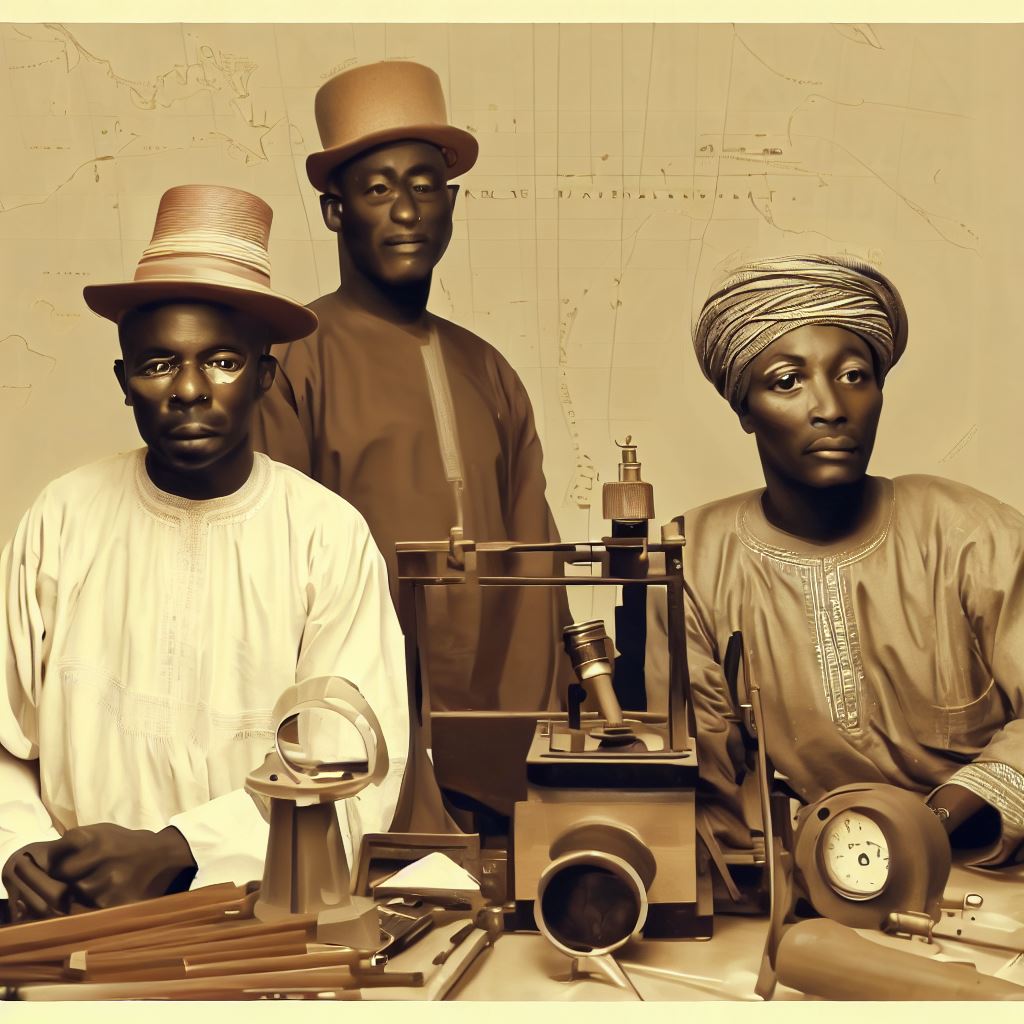Introduction
Technology in cartography
The topic of technology in cartography refers to the advancements and applications of technology in the field of map-making and spatial analysis.
Nigeria’s mapping industry plays a crucial role in the development and management of the country’s geographic data and resources.
Cartography, the science and art of map-making, has significantly evolved with advancements in technology.
In this blogspot, we will explore the trends and developments in technology that have revolutionized Nigeria’s mapping industry.
Nigeria’s mapping industry encompasses various sectors, such as land surveying, geographic information systems (GIS), and remote sensing.
Brief overview of Nigeria’s mapping industry
In recent years, Nigeria has witnessed a paradigm shift in its mapping practices, thanks to the integration of modern technologies.
Traditional methods of data collection and map creation have been replaced by more efficient and accurate digital techniques.
This shift has not only improved the quality of maps but has also accelerated the process of decision-making and development planning.
The application of GIS technology has been instrumental in creating interactive and dynamic maps that enable users to analyze, visualize, and interpret geographic data effectively.
By integrating different layers of spatial data, GIS provides valuable insights into various aspects of Nigeria’s landscape, such as infrastructure development, urban planning, and natural resource management.
Furthermore, remote sensing technology, including satellite imagery and aerial photography, has revolutionized the way Nigeria’s mapping industry captures and monitors spatial data.
These high-resolution images allow for detailed and up-to-date mapping and monitoring of land use, vegetation, and changes in the natural environment.
In all, technology has significantly transformed Nigeria’s mapping industry, improving the accuracy and efficiency of map-making processes.
The integration of GIS and remote sensing has revolutionized data analysis and visualization, enabling better decision-making and resource management.
The following sections will delve deeper into these emerging trends and their impact on Nigeria’s cartography landscape.
Traditional Mapping Techniques in Nigeria
Traditional methods used in mapping
- Triangulation: Using a network of triangles to determine the position of points on the Earth’s surface.
- Plane Table Survey: A method where a table with a map is set up in the field and observations are recorded.
- Compass Traverse: A technique that uses a compass to measure the direction of lines and angles between points.
- Chain Survey: The process of measuring distances between points using a chain or tape.
- Traversing: Moving from one point to another through a series of angles and distances.
Limitations and challenges of traditional mapping in Nigeria
Traditional mapping methods, though historically significant, exhibit several drawbacks in Nigeria:
- Time-Consuming: Conventional techniques rely on manual labor, consuming excessive time when compared to modern methods.
- Inaccuracies: Errors in measurements, calculations, and map drawing introduce inaccuracies in the final product.
- Limited Scope: Traditional mapping suits small areas but inadequately addresses large-scale projects.
- Remote Challenges: Reaching remote and inaccessible areas in Nigeria poses difficulties, impeding traditional mapping.
- High Costs: Equipment and manpower demands inflate expenses for traditional methods.
- Outdated Information: Updates lag in traditional maps as real-time changes remain unrepresented.
- Limited Data Integration: Data from diverse sources is poorly integrated, impacting overall accuracy.
- Collaboration Hurdles: Sharing and collaborating on physical maps proves cumbersome.
Despite these constraints, traditional mapping has a vital historical role in Nigeria, establishing foundational base maps.
However, embracing modern tools like Geographic Information Systems (GIS), Remote Sensing, and Global Positioning Systems (GPS) can overcome these limitations.
These advanced technologies promise enhanced accuracy, efficiency, and accessibility, enabling Nigeria to align with global cartographic trends.
In essence, traditional mapping, while historically significant, bears limitations.
Transitioning to modern mapping technologies can revolutionize Nigeria’s mapping industry, fostering precision, timeliness, and accessibility.
Embracing cartographic technology is imperative for Nigeria to stay abreast of global mapping advancements.
Technological Advancements in Cartography
Emergence of GIS (Geographic Information System) in Nigeria
- GIS has revolutionized cartography in Nigeria by providing accurate spatial data.
- The use of GIS has greatly improved mapping processes and decision-making in the country.
- Nigeria is seeing a significant increase in the adoption and implementation of GIS technology.
- Government agencies, research institutions, and private organizations are actively using GIS for mapping purposes.
- GIS helps in capturing, managing, analyzing, and presenting geospatial data effectively.
Benefits and advantages of using GIS in mapping
- GIS allows for the integration of various types of geospatial data, enhancing map accuracy and efficiency.
- It enables the analysis of complex geospatial relationships, providing valuable insights for decision-making.
- GIS assists in resource management, urban planning, disaster management, and infrastructure development.
- The use of GIS reduces costs and saves time, as manual mapping processes are replaced by automated techniques.
- GIS aids in the identification of spatial patterns, trends, and hotspots for better planning and development.
Other technological advancements such as remote sensing and GPS (Global Positioning System)
- Remote sensing technology plays a crucial role in mapping by gathering data from a distance.
- Satellites and aerial imagery provide high-resolution images, which are used to create accurate maps.
- Remote sensing helps in monitoring land use changes, environmental dynamics, and natural resource management.
- GPS technology enables precise positioning and navigation, improving field data collection.
- GPS receivers are used to collect ground control points for accurate georeferencing of maps.
- Nigeria is leveraging GPS technology to map remote and inaccessible areas, aiding in disaster management.
Applications of Technology in Nigerian Mapping
Improved Land Surveying and Boundary Delineation in Nigeria
- Technology in land surveying has revolutionized the accuracy and efficiency of mapping in Nigeria.
- Advanced surveying tools such as GPS and remote sensing techniques have enhanced precision in measuring land boundaries.
- High-resolution aerial imagery and satellite data enable surveyors to capture detailed information for accurate boundary delineation.
- Digital mapping software facilitates the integration of survey data, reducing errors and increasing reliability.
- The utilization of Geographic Information Systems (GIS) allows for the effective management of survey data and easy retrieval of information.
- With technology, land surveyors in Nigeria can now avoid many of the challenges faced in manual surveying techniques.
- The use of automated surveying instruments minimizes human errors and discrepancies in determining land boundaries.
- Real-time kinematic (RTK) positioning systems provide precise positioning information, resulting in accurate mapping and land surveying outcomes.
- The application of technology in land surveying has significantly improved land titling and property registration processes in Nigeria.
Technology’s Role in Creating Accurate and Up-to-date Maps for Urban Planning and Development
- Technology plays a crucial role in urban planning and development by providing accurate and up-to-date maps.
- Geographic Information Systems (GIS) enable urban planners to analyze spatial data for effective decision-making.
- Digital mapping tools integrate various layers of information, including infrastructure, transport networks, and land use, for comprehensive urban planning.
- Real-time mapping applications assist in monitoring urban growth, identifying areas for development, and managing resources efficiently.
- High-resolution satellite imagery allows for detailed mapping of urban areas, capturing changes in land use patterns over time.
- Advanced sensors and LiDAR technology provide three-dimensional data for urban modeling and simulation.
- By utilizing technology, urban planners can identify potential environmental impacts and develop sustainable development strategies.
- Collaborative mapping platforms enable public participation in urban planning processes, enhancing transparency and inclusiveness.
- Technology also aids in disaster management and emergency response by providing accurate mapping for evacuation planning and resource allocation.
Technology’s Contribution to Natural Resource Management and Environmental Conservation
- Technology plays a vital role in the effective management of natural resources and environmental conservation in Nigeria.
- Remote sensing and satellite imagery help identify and monitor changes in forest cover, wetlands, and other natural habitats.
- Geospatial analysis tools assist in assessing biodiversity, land degradation, and ecosystem health for informed conservation efforts.
- Geographic Information Systems (GIS) support the development of land-use plans that balance economic activities with environmental conservation.
- GPS technology facilitates the mapping and monitoring of protected areas, facilitating better wildlife management and conservation strategies.
- Technology aids in tracking illegal activities such as deforestation, poaching, and illegal mining, enabling timely intervention.
- Mobile mapping applications empower local communities to participate in environmental monitoring and reporting of ecological issues.
- Real-time environmental monitoring systems help in detecting and responding to pollution incidents and natural disasters.
- Technology also aids in climate change adaptation and mitigation strategies by providing data for modeling and decision-making.
Overall, technology has revolutionized mapping in Nigeria, improving land surveying accuracy, urban planning, and natural resource management.
With the integration of advanced tools and techniques, Nigeria can achieve more precise land boundaries, effective urban development, and sustainable environmental conservation.
The application of technology in mapping continues to play a pivotal role in Nigeria’s socioeconomic advancement.
Read: How to Become a Cartographer in Nigeria: A Guide

Challenges and Opportunities
Challenges of adopting and implementing technology in Nigerian mapping
- Limited access to technology and internet connectivity hinder the adoption of advanced mapping tools.
- Insufficient funding for acquiring and maintaining mapping technology poses a significant challenge.
- Outdated infrastructure and lack of proper maintenance impede the effective implementation of technology in mapping.
- Limited technical expertise and skills among Nigerian cartographers create barriers to the adoption of new technologies.
- Resistance to change and reluctance to embrace technology among traditional mapping practitioners hinder progress.
Need for infrastructure development and technological capacity-building
- Adequate investment in infrastructure development is crucial for enabling the adoption and implementation of technology in mapping.
- Improvement in internet connectivity and access to reliable electricity are essential for utilizing technology effectively.
- Capacity-building programs should be introduced to educate mapping professionals on the use of advanced tools and software.
- Collaborations with international organizations can help provide necessary resources and training for technological capacity-building.
- Developing a robust technological infrastructure will enhance data collection, analysis, and dissemination in mapping.
Potential for innovation and collaboration in the field
- Embracing technological advancements can lead to innovative mapping techniques and tools in Nigeria.
- Collaboration between government agencies, private sector, and research institutions can foster innovation in mapping technology.
- The development of indigenous mapping solutions tailored to Nigeria’s specific needs can promote self-reliance and sustainability.
- Innovative mapping technologies can support urban planning, disaster management, and resource allocation in Nigeria.
- Creating a culture of collaboration and knowledge sharing within the mapping community will drive innovation and progress.
Most Importantly, while there are challenges to adopting and implementing technology in Nigerian mapping, such as limited access to technology, lack of funding, and resistance to change, there are also opportunities for infrastructure development, capacity-building, and fostering innovation and collaboration.
By addressing these challenges and seizing these opportunities, Nigeria can unlock the full potential of technology in cartography and contribute to sustainable development and effective decision-making.
Case Studies of Successful Technological Integration in Nigerian Mapping
Examples of Nigerian organizations or projects that have effectively utilized technology in cartography:
- The Nigerian National Space Research and Development Agency (NASRDA).
- The Geoinformation Department of the National Population Commission (NPC).
- The OpenStreetMap Nigeria project.
- The Nigerian Oil and Gas industry’s adoption of GIS technology.
- The Nigerian Geological Survey Agency (NGSA) using digital mapping tools.
Impact and benefits of these case studies:
The Nigerian National Space Research and Development Agency (NASRDA) has masterfully harnessed satellite imagery and remote sensing data, elevating the precision of Nigeria’s mapping systems.
This has facilitated enhanced monitoring of land use, environmental shifts, and infrastructure development.
The Geoinformation Department of the National Population Commission (NPC) adeptly wields technology in cartography, bolstering census mapping.
Employing geographic information systems (GIS), they efficiently gather, analyze, and visualize population data, driving superior national-level planning, resource allocation, and policy formulation.
The OpenStreetMap Nigeria project, a community-driven mapping initiative, skillfully employs crowdsourcing and technology to forge intricate, current maps of Nigerian urban and rural regions.
This invaluable spatial information aids emergency response, urban planning, and community involvement.
In the Nigerian Oil and Gas sector, GIS integration revolutionizes mapping, enhancing exploration and production efficiency, reducing costs, and refining environmental management.
The Nigerian Geological Survey Agency (NGSA) proficiently wields digital mapping tools for geological mapping and mineral exploration, enabling resource evaluation, informed investments, and mining sector growth.
In summary, these Nigerian entities and endeavors exemplify the adept integration of technology in cartography, fostering precise mapping, cost-efficiency, improved resource allocation, and enhanced decision-making.
They stand as inspirational models of successful technological fusion in Nigerian mapping.
Read: Skills Needed to Thrive in Nigerian Cartography
Explore Further: Job Growth for Data Analysts in Nigeria: Forecast
Future Trends in Nigerian Mapping Technology
Potential advancements and trends that could shape the future of mapping in Nigeria
- Integration of Artificial Intelligence (AI) and Machine Learning (ML) algorithms into mapping software.
- Development of advanced satellite imaging technology for more accurate mapping and data collection.
- Implementation of geospatial data analytics for better resource management and decision-making.
- Utilization of virtual and augmented reality in mapping applications for enhanced user experience.
- Integration of Internet of Things (IoT) devices and sensors to gather real-time data for mapping purposes.
- Incorporation of blockchain technology for secure and decentralized storage and sharing of mapping data.
- Exploration of 3D mapping technologies to create immersive and detailed representations of geographical areas.
- Application of drones for efficient mapping of inaccessible or hazardous terrains.
- Development of mobile mapping applications for on-the-go data collection and mapping.
- Integration of social media and crowdsourcing into mapping platforms to gather user-generated data.
Importance of adapting to new technologies for continued growth and development
In order for Nigeria to stay at the forefront of mapping technology, it is essential to embrace and adapt to new advancements.
Here are some reasons why:
- Improved Efficiency: New technologies can streamline mapping processes, reduce errors, and enhance productivity.
- Enhanced Accuracy: Advanced mapping tools and techniques provide more precise and reliable data, leading to better decision-making.
- Increased Accessibility: Adapting to new technologies allows for wider access to mapping applications and data, benefiting various sectors.
- Effective Resource Management: Utilizing new mapping technologies enables better management of natural resources and infrastructure.
- Enhanced Disaster Response: Up-to-date mapping data can aid in emergency planning and response, saving lives and minimizing damage.
- Support for Sustainable Development: Accurate mapping data facilitates planning for sustainable urbanization, transportation, and environmental conservation.
- Improved Infrastructure Planning: Mapping technology provides valuable insights for the design and maintenance of transportation networks and utilities.
- Economic Growth: Advanced mapping technologies can attract investment, stimulate innovation, and create jobs in the mapping industry.
- Competitive Advantage: Embracing new mapping technologies helps Nigeria stay competitive globally and attract international collaborations.
Ultimately, the future of mapping in Nigeria holds significant potential with the emergence of new technologies.
By embracing these advancements, Nigeria can revolutionize its mapping systems and drive growth and development across various sectors.
Read: Trends in Actuarial Recruitment in Nigeria: What to Expect in 2023
You Might Also Like: Women in Nigeria’s Librarian Profession: Spotlight
Conclusion
In this blog post, we explored the trends in technology in cartography in Nigeria.
The potential impact of technology on Nigeria’s mapping industry is immense.
It is crucial to encourage further exploration and adoption of technology in cartography in Nigeria to enhance its mapping capabilities.
Key Points Discussed:
- Technology is revolutionizing cartography in Nigeria.
- GIS and remote sensing enhance precision.
- Digital mapping aids urban planning.
- Mobile apps improve accessibility.
- Big data powers comprehensive mapping.
Impact of Technology
- Technology boosts mapping accuracy.
- It supports disaster management.
- Urban development benefits from tech-driven maps.
- Accessibility improves with digital tools.
- Big data provides insights for policymakers.
Embrace Technology in Cartography:
- Nigeria must invest in tech-driven cartography.
- Training programs for cartographers are essential.
- Collaborate with tech companies for innovation.
- Technology can elevate Nigeria’s mapping industry.
Finally, Nigeria’s mapping future lies in technology. Let’s embrace it for a more precise and informed future.




